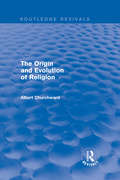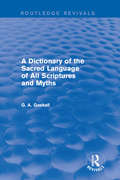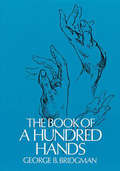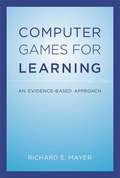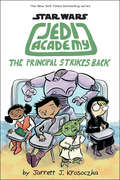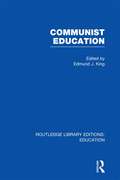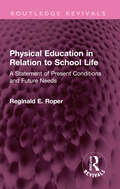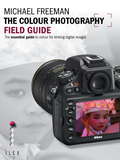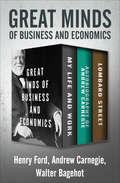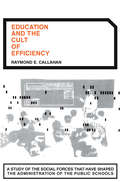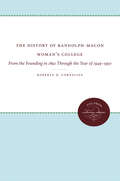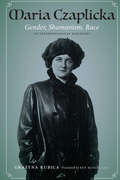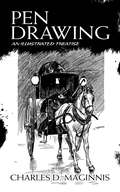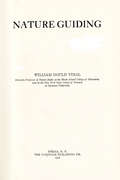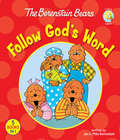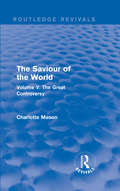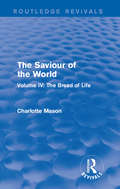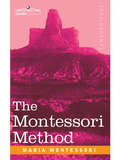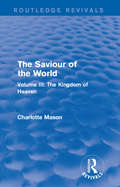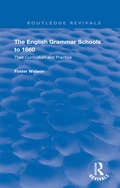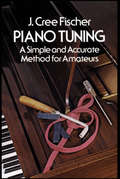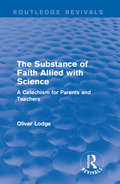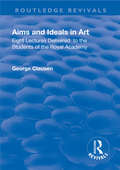- Table View
- List View
The Origin and Evolution of Religion (Routledge Revivals)
by Albert ChurchwardChurchward’s The Origin and Evolution of Religion, first published in 1924, explores the history and development of different religions worldwide, from the religious cults of magic and fetishism to contemporary religions such as Christianity and Islam. This text is ideal for students of theology.
A Dictionary of the Sacred Language of All Scriptures and Myths (Routledge Revivals)
by G GaskellG. A. Gaskell’s Dictionary of the Sacred Language of All Scriptures and Myths, first published in 1923, examines several different aspects of religion, including examples from Ancient Egyptian religion and mythology to modern-day Christianity, providing explanations of gods, events, and symbols in alphabetical order. This is a perfect reference book for students of theology or the history of religion.
The Book of a Hundred Hands (Dover Anatomy for Artists)
by George B. BridgmanMr. Bridgman states unequivocally in his introduction that before preparing this book he had "not discovered a single volume devoted exclusively to the depicting of the hand." Apparently Mr. Bridgman has appreciated what few others have felt -- the human hand's great capacity for expression and the care that the artist must take to realize it. The hand changes with the age of the person, is shaped differently according to sex, reflects the type of work to which it is put, the physical health, and even the emotions of the person. To represent these distinguishing features, to capture the expressiveness of a particular pair of hands, the artist must understand the construction, anatomy, formation, and function of the hand.There is probably no better instructor to turn to for this understanding than Mr. Bridgman, a well-respected artist who for nearly 50 years lectured and taught at the Art Students League of New York. In this volume, a full text is accompanied by many illustrations depicting virtually every aspect and posture of the human hand. He first considers the back view of the hand, the wrist bones, the tendons, the muscles, the hand bones, the arch, and the veins; and then those of the palm. Throughout he pictures the musculature at work beneath the surface of the skin. He continues by showing how the muscles operate on the thumb side and on the little finger side when each is the center of force; how the thumb and fingers are constructed, their freedom of movement, joints, and complete anatomy as well as views of them straight, bent, and flexed; how the knuckles are formed, what shapes the fist can take and how flexible it can be; and he concludes with illustrations of the total movement, either turning or rotary, of the hand in its various positions.The 100 illustrations the author has selected perfectly define the regions of the hand so that any artist, beginning or experienced, will increase his mastery of it. Better rendering of the human hand is sure to add new expressiveness to your human figures along with new forcefulness and new interest.
Computer Games for Learning
by Richard E. MayerMany strong claims are made for the educational value of computer games, but there is a need for systematic examination of the research evidence that might support such claims. This book fills that need by providing, a comprehensive and up-to-date investigation of what research shows about learning with computer games. Computer Games for Learning describes three genres of game research: the value-added approach, which compares the learning outcomes of students who learn with a base version of a game to those of students who learn with the base version plus an additional feature; the cognitive consequences approach, which compares learning outcomes of students who play an off-the-shelf computer game for extended periods to those of students who do not; and the media comparative approach, which compares the learning outcomes of students who learn material by playing a game to those of students who learn the same material using conventional media. After introductory chapters that describe the rationale and goals of learning game research as well as the relevance of cognitive science to learning with games, the book offers examples of research in all three genres conducted by the author and his colleagues at the University of California, Santa Barbara; meta-analyses of published research; and suggestions for future research in the field. The book is essential reading for researchers and students of educational games, instructional designers, learning-game developers, and anyone who wants to know what the research has to say about the educational effectiveness of computer games.
The Principal Strikes Back (Star Wars: Jedi Academy #6)
by Jarrett J. KrosoczkaAs told through a mix of comics, doodles, and journal entries, it's Victor Starspeeder's third year at Jedi Academy! It's also his first year EVER without his sister, Christina. Plus, things at Jedi Academy are... weird. After last year's security breach, Principal Marr has been demoted and replaced with Commander ZC-04, a big, scary droid. There's a curfew, new regulations, and everyone is on edge. But when Victor and his friends dig a little deeper into the changes at the school, they find that there's a lot more to this story than the droids want to admit! It's an all-new, out-of-this-world Jedi Academy adventure as The Principal Strikes Back!
Communist Education (Routledge Library Editions: Education)
by Len Barton Martin LawnDevelopments and trends in Communist education are traced in this authoritative survey by specialists. Eight chapters deal with particular aspects: ideology, psychology, the selective process, the roles of teachers and parents, polytechnical education, the universities and professional institutes. Three chapters survey the former East Germany, Poland and China as special case-studies. A concluding chapter examines common ground between Communist and other systems.
Physical Education in Relation to School Life: A Statement of Present Conditions and Future Needs (Routledge Revivals)
by Reginald E. RoperFirst published in 1917, Physical Education in Relation to School Life views the problems of growth and health in relation to education. The main outlines of a satisfactory physical education and its importance are indicated. The author has compared his aims and objectives, and appreciated the practical value of some of the better-known methods of dealing with the problems, and has suggested the direction in which future improvements may most usefully be sought. This book will be of interest to students of physical education, pedagogy and history.
The Colour Photography Field Guide: The Essential Guide To Colour For Striking Digital Images (Field Guide Ser.)
by Michael FreemanDigital cameras and powerful image-processing software applications provide today's photographer with all the tools needed to explore the world of colour. Renowned photographer and author Michael Freeman provides a thorough look at the essential ways of dealing with colour that will help photographers create striking colour digital photographs. Using helpful tips and exercises, he covers everything from capture and calibration to workflow management and output.
Great Minds of Business and Economics: My Life and Work, Autobiography of Andrew Carnegie, and Lombard Street
by Henry Ford Andrew Carnegie Walter BagehotThree classic works on the art of succeeding in business, life, and high finance from three of modern history&’s most influential thought leaders. My Life and Work: A legendary inventor and industrialist, Henry Ford pioneered the American automotive industry. In this combination of memoir and business treatise, he describes his early life as a mechanically inclined farmer&’s son, the inner workings of his eponymous motor company, and the development of the Model T. He also discusses key workplace principles such as compensating workers beyond the prevailing wage and building a diverse workforce. The Autobiography of Andrew Carnegie: Scottish immigrant Andrew Carnegie worked his way up from bobbin boy to telegraph operator to railroad man, learning lessons along the way that would lead to his unparalleled success in the steel industry. In this acclaimed memoir, he shares his story of living the American dream, as well as insights on education, business, and the need to give back for the common good. Lombard Street: Written in response to a nineteenth-century banking crisis in England, Walter Bagehot&’s influential treatise was one of the first to clearly explain complex financial systems in accessible language. As editor in chief of the Economist, Bagehot also makes proposals for strengthening the economy, such as allowing irresponsible banks to collapse and creating strong central banks to combat inflation. His insights are as relevant today as they were when the book was first published in 1873.
Twelfth Night
by William Shakespeare: Edited by Google booksIn this edition of Shakespeare an attempt is made to present the greater plays of the dramatist in their literary aspect, and not merely as material for the study of philology or gramMar. Criticism purely verbal and textual has only been included to such an extent as may serve to help the student in the appreciation of the essential poetry. Questions of date and literary history have been fully dealt with in the Introductions, but the larger space has been devoted to the interpre¬tative rather than the matter-of-fact order of scholar¬ship. ?sthetic judgments are never final, but the Editors have attempted to suggest points of view from which the analysis of dramatic motive and dramatic character may be
To The Light House
by Virginia Woolf Edited by RL. VARSHNGYAs literature is the reflection of society, so is the writer the product of society. On the one hand he influences society by writing his ideas and thoughts ; on the other hand, he is influenced by a number of factors prevailing in the society. Social and literary conventions, political, economic, educational and religious atmosphere of the society influence him a great deal besides the individuals.
Education and the Cult of Efficiency: A Study of the Social Forces That Have Shaped the Adminstration of the Public Schools
by Raymond E. CallahanRaymond Callahan's lively study exposes the alarming lengths to which school administrators went, particularly in the period from 1910 to 1930, in sacrificing educational goals to the demands of business procedures. He suggests that even today the question still asked is: "How can we operate our schools?" Society has not yet learned to ask: "How can we provide an excellent education for our children?"
The History of Randolph-Macon Woman's College: From the Founding in 1891 Through the Year of 1949-1950
by Roberta D. CorneliusThe history of Randolph-Macon Woman's College has a claim upon the attention of all who are interested in the education and achievement of women. Its course through the years is set forth in the present volume, in which the author has dealt with the pattern of life developed in the cultivation of the liberal arts.Originally published in 1951.A UNC Press Enduring Edition -- UNC Press Enduring Editions use the latest in digital technology to make available again books from our distinguished backlist that were previously out of print. These editions are published unaltered from the original, and are presented in affordable paperback formats, bringing readers both historical and cultural value.
Maria Czaplicka: Gender, Shamanism, Race (Critical Studies in the History of Anthropology)
by Grazyna KubicaThis biography of the Polish British anthropologist Maria Czaplicka (1884–1921) is also a cultural study of the dynamics of the anthropological collective presented from a researcher-centric perspective. Czaplicka, together with Bronisław Malinowski, studied anthropology in London and later at Oxford, then she headed the Yenisei Expedition to Siberia (1914–15) and was the first female lecturer of anthropology at Oxford. She was an engaged feminist and an expert on political issues in Northern Asia and Eastern Europe. But this remarkable woman&’s career was cut short by suicide. Like many women anthropologists of the time, Czaplicka journeyed through various academic institutions, and her legacy has been dispersed and her field materials lost. Grażyna Kubica covers the major events in Czaplicka&’s life and provides contextual knowledge about the intellectual formation in which Czaplicka grew up, including the Warsaw radical intelligentsia and the contemporary anthropology of which she became a part. Kubica also presents a critical analysis of Czaplicka&’s scientific and literary works, related to the issues of gender, shamanism, and race. Kubica shows how Czaplicka&’s sense of agency and subjectivity enriched and shaped the practice of anthropology and sheds light on how scientific knowledge arises and is produced.
Pen Drawing: An Illustrated Treatise
by Charles D. MaginnisStyle, materials, techniques, and values are the focus of this richly illustrated guide to pen drawing. In addition to proposing solutions for practical problems, the book offers advice on architectural and decorative drawing. More than 70 drawings by assorted artists range from tranquil churchyards and bustling city streets to striking posters. Many of the images are derived from The Century Magazine, Harper's Magazine, The Architectural Review, and other illustrated periodicals of the early twentieth century.Irish-American architect Charles D. Maginnis (1867-1955), a co-founder of the firm Maginnis & Walsh, was active in the design of ecclesiastical and campus buildings across the United States. He also served as President of the American Institute of Architects from 1937-39. Maginnis' practical guide to pen drawing features several of his own illustrations, created expressly for this instructive volume.
Nature Guiding
by William Gould VinalNature Guiding is the science of inculcating nature enthusiasm, nature principles, and nature facts into the spirit of individuals. "Doing" nature-study means observing, wondering, and solving problems. It could include collecting, building, measuring, painting, planning, writing, touching, experimenting or any of a wide range of other activities. Most importantly, it allows children to be "original investigators."This book is intended as a resource for teachers and students engaged in nature study at summer camps and in schools. William Gould Vinal believed that the teacher of nature study should be "in sympathy with the simple life and the country way," that the nature study should emphasize observation of the interactions of plants and animals in their environment, and not be reduced to matters of taxonomy and anatomy. In Nature Guiding, he offers advice to camp counselors and school teachers on incorporating nature study into everyday activities, as well as suggestions for parents and others about using visits to state and national parks to teach nature lore.
The Berenstain Bears Follow God's Word (Berenstain Bears/Living Lights)
by Jan BerenstainThis five-book collection of the highly popular Living Lights™ Berenstain Bears® stories provides children with an ideal gift they will enjoy for years to come. The biblical values, morals, and life lessons are invaluable for children throughout every stage of their lives.
The Saviour of the World: Volume V: The Great Controversy (Routledge Revivals)
by Charlotte M MasonThe Saviour of the World covers each incident and each saying in the Bible and converts them to either a single poem, blank verse or rhymed stanza, according to the subject. This volume, called The Great Controversy, was originally published in 1911. This book will be of interest to students of both religious studies and English literature.
The Saviour of the World: Volume IV: The Bread of Life (Routledge Revivals)
by Charlotte M MasonThe Saviour of the World covers each incident and each saying in the Bible and converts them to either a single poem, blank verse or rhymed stanza, according to the subject. This volume, called The Bread of Life, was originally published in 1910. This book will be of interest to students of both religious studies and English literature.
The Montessori Method
by Maria MontessoriThis groundbreaking classic of educational philosophy takes on urgent new necessity today, as "traditional" methods of early-childhood schooling seem to be failing us. Published in Italian in 1909 and first translated into English in 1912, these still-revolutionary theories focus on the individuality of the child and on nurturing her inherent joy of learning to create schools and other learning environments that are oriented on the child. Eschewing rote memorization and drilling, Montessori's method helps to foster abstract thinking and to fulfill a child's highest potential, emotionally, physically and intellectually. Parents from all walks of life will find the ideas herein immensely valuable.
The Saviour of the World: Volume III: The Kingdom of Heaven (Routledge Revivals)
by Charlotte M MasonThe Saviour of the World covers each incident and each saying in the Bible and converts them to either a single poem, blank verse or rhymed stanza, according to the subject. This volume, called The Kingdom of Heaven, was originally published in 1909. This book will be of interest to students of both religious studies and English literature.
The English Grammar Schools to 1660: Their Curriculum and Practice (Routledge Revivals)
by Foster WatsonFirst published in 1908, this important work on the history of education traces the development of teaching in English Grammar Schools from the invention of printing up to 1660. It is not a history of the theories of educational reformers as to what should or should not be taught, but a history of the actual practices of the schools, of their curricula and of the differentiated subjects of instruction. The author relies heavily on the textbooks used in schools in the sixteenth and seventeenth centuries, in particular the ‘Ludus Literarius’ of John Brinsley and the ‘New Discovery of the Old Art of Teaching School’ of Charles Hoole, and makes free use of the School Statutes which state the express intention of the Founder as to what was to be taught. The period covered is one of great significance in which the Encyclopaedia of the medieval curriculum was abandoned for the modern practice of the differentiation of school subjects. The new knowledge of the Renaissance and the introduction of critical methods and of close analysis gave students a detailed knowledge which could not be fitted into the rigid confines of the medieval Encyclopaedia, while the invention of printing enormously facilitated the increase and spreading of text books for both teachers and pupils.
Piano Tuning: A Simple and Accurate Method for Amateurs (Dover Books On Music: Piano)
by J. Cree FischerIf you have a note that has dropped in pitch, do you have to call in the tuner? A stuck key? Sympathetic rattle? Missing bridles? A broken hammer shank? An unglued ivory? The answer, in each case, is no: you can make all of these repairs yourself!This is the clearest and most complete book available for beginning tuners and amateur pianists. It explains all the basic processes practically and with model clarity. A non-musician can use this book without too much difficulty.You will learn how upright, grand, and square actions work, and how to take care of the smallest repairs — repairing stuck keys, poorly adjusted bottoms and capstans, crowded back checks, felts and leather on the hammers, hammer stems; softening damper and hammer felts; installing new bridles; eliminating "sympathetic rattle"; all with a minimum of tools and training.You will learn a professional method of tuning based on slightly flattened fifths, where only the octave and the upward fifth intervals are used. This is one of the easiest systems to learn, one capable of a great deal of control, and one perfectly suited to adjusting one or two keys. It is a tested method especially right for amateurs working without a teacher, and a method that trains the ear for other recommended systems. The author also explains "beats," the theory of the tempered scale, and useful experiments you can make with harmonic phenomena.If you want to experiment with tuning a piano, there is no better book to start with. It will help performers and teachers make occasional repairs and learn the structure and scale of the piano. Those who want to know how pianos work will find this book both clear and useful.
The Substance of Faith Allied with Science: A Catechism for Parents and Teachers (Routledge Revivals)
by Oliver LodgeOriginally published in 1907, this book provides information to parents and teachers wishing to teach their children about Christianity as well as science. Lodge details his fear of mandatory secularism in schools and advises how to instruct children in science without allowing any doubt of Christian doctrine and stresses the importance of reconciliation between religion and science for future generations. This title will be of interest to students of Education and Religion.
Revival: Eight lectures delivered to the students of the Royal Academy (Routledge Revivals)
by George ClausenGeorge Clausen delivers these eight lectures to the students of The Royal Academy of Arts about the aims and ideals of art. He includes the truth to nature and style within art and explores the imagination and taste in drawing and using colour.
